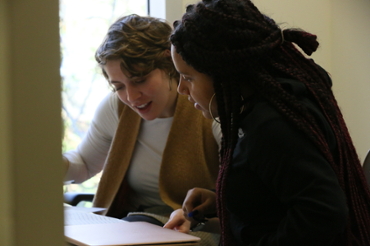Guidelines for Addressing Concerns About Faculty Behavior
Updated 3/11/2024
The Graduate School of Arts & Sciences hears from students who share concerns about faculty behavior they feel is inappropriate.This document intends to offer guidance for GSAS students on how to share concerns about demeaning or bullying behaviors by faculty. There are separate pathways for reporting concerns about discrimination, harassment, sexual misconduct, and academic grievance, as outlined in the “Reporting Other Types of Concerning Behavior” section of this document. It’s important to note that staff and faculty, outside of those who are identified as confidential resources, are considered responsible reporters, meaning they must share any information that has been disclosed to them regarding discrimination, harassment, and sexual misconduct with the Office of Equal Opportunity.
For the purpose of this document, demeaning or bullying behaviors include, but are not limited to, the intentional and repeated display of the following behaviors:
- Verbal Bullying:
- Name-calling: Using derogatory and offensive language to mock or insult the target. Can be microaggression or direct aggression.
- Teasing and taunting: Repeatedly criticizing someone's appearance, abilities, or personal characteristics.
- Threats: Expressing intent to harm, physically or verbally. Including threats to harm academic progress.
- Insults: Using hurtful words or phrases to demean or belittle the target.
- Raising one’s voice in a public place or classroom: Engaging in actions meant to humiliate or emotionally/physically harm the target.
- Physical Bullying: Using physical presence to intimidate, injure, or control the victim.
- Relational Bullying:
- Inappropriate task assignment: Asking students to perform tasks or errands that are personal and fall outside a TA/CA role or typical academic expectations
- Exclusion: Purposefully leaving someone out of social activities, groups, or conversations.
- Spreading rumors: Sharing false or private damaging information about the target to tarnish their reputation.
- Social manipulation: Coercing others to ignore or avoid the victim, isolating them socially.
- Cyberbullying:
- Harassment online: Sending hurtful, threatening, or demeaning messages through social media, email, or other digital platforms.
- Posting hurtful content: Sharing embarrassing photos, videos, or personal information without consent.
- Trolling: Making inflammatory or offensive comments with the intent to provoke and upset the target.
- Indirect Bullying:
- Manipulation: Using manipulation or coercion to control or exploit the victim emotionally.
- Intimidation: Creating fear through threats or gestures without direct physical contact.
Difference Between Productive Academic Feedback and Bullying Behavior
Sometimes it is difficult to distinguish between academic feedback and personal critique. These distinctions also vary by national context, language, and cultural norms. In the United States, academic feedback focuses on the work, not the person. Personal critique is inappropriate in a professional environment and can include demeaning or bullying behaviors. This includes actions that go beyond rude or uncivil behavior or conflict of personality and refer to repeated aggressive, hurtful, or harmful actions intended to intimidate, belittle, or harm another person. Such behaviors can manifest in various forms and settings, including in-person and online virtual workplace settings, classrooms, online platforms, and within the larger community.
Examples of Productive Academic Feedback and Bullying Behavior
Academic feedback: “You need more background in concept X to be successful in this course. I recommend reviewing your texts from undergrad to bring yourself up to speed.”
Bullying: “I can’t believe you don’t know concept X! How did we let you into graduate school?”
Academic feedback: “Your presentation is a good start and it still needs a lot of work. I would suggest focusing on x, y, and z in your next draft.”
Bullying: “Your presentation shows you don’t know anything about this field.”
Academic feedback: “These chapters are poorly written and need a lot of revision.”
Bullying: “Who taught you to write? This is awful.”
If you are unsure if something is productive academic feedback vs. bullying behavior, we encourage you to have a conversation with a staff or faculty member identified in the “How to Share Concerns Section”. To learn more about the norms for academic feedback in your discipline/field, you can also consider asking faculty to share with you reviews they have received from peer-reviewed journals in the field.
How to Share Concerns
Demeaning or bullying behaviors are best addressed with the Director of Graduate Studies and/or the Chair of the Department/Program. GSAS staff including staff in the Division of Science can also offer support. If that is not possible, students can report concerns directly to the Senior Associate Dean for Faculty Affairs in Arts & Sciences. The Senior Associate Dean will work with departmental personnel to ensure that all University policies and procedures are being followed appropriately. In certain conditions, the Senior Associate Dean may consult with the Senior Associate Provost for Faculty Affairs while working toward a resolution
Further Resources
An unhealthy working relationship with a faculty member, especially with one’s PI/dissertation or thesis advisor, often impacts students’ mental health and well-being. Students are encouraged to access resources such as the GSAS Assistant Deans of Student or Academic Affairs, support structures from their program and department, and confidential resources such as the University Ombuds and the Brandeis Counseling Center.
Reporting Other Types of Concerning Behavior
Concerns related to academic grievances such as academic decisions and milestones like comprehensive or qualifying exam results, language exams, or grades in coursework are handled through GSAS’s Academic Grievance Procedure. The Division of Science’s Norms and Expectations are an important reference as are the materials about authorship available in the CITI training program required through the Human Research Protection Program.
Concerns related to issues of discrimination or harassment based on a protected category, and sexual violence as described in the Brandeis Policy on Discrimination, Harrassment and Sexual Violence are addressed by the Office of Equal Opportunity. Protected categories include race, color, national origin/ethnicity, caste, sex, pregnancy, sexual orientation, gender identity/expression, including transgender identity, religion, disability, age, genetics, active military or veteran status, and any other characteristics protected under applicable federal or Massachusetts law.
Behavior that should be reported to OEO includes, but is not limited to:
- Sexual Bullying
- Unwanted advances: Making unwelcome sexual comments, gestures, or advances.
- Sexual harassment: Engaging in persistent, unwelcome sexual behavior that creates a hostile environment for the target.
- Prejudicial Bullying:
- Discrimination: Targeting someone based on their race, ethnicity, gender, sexual orientation, religion, or other protected characteristics.
- Homophobic or transphobic behavior: Bullying someone due to their actual or perceived sexual orientation or gender identity.
______________________________________________________________________
Resources Consulted:
* University of California, Berkeley . (n.d.). GUIDELINES FOR PREVENTING AND RESPONDING TO FACULTY BULLYING AND OTHER DEMEANING & DISRUPTIVE BEHAVIOR. https://vpf.berkeley.edu/sites/default/files/guidelines_re_bullying_8.5.19.pdf
* American Psychological Association. (n.d.). Bullying. American Psychological Association. https://www.apa.org/topics/bullying#:~:text=Bullying%20is%20a%20form%20of,words%2C%20or%20more%20subtle%20actions.






